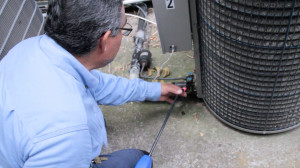 Freon leakages from ACs have adverse effects on health and the AC unit itself. This is why it is important to keep these levels on check each and every time. Freon refers to the trademark name given to the chlorofluorocarbons refrigerant manufactured by DuPont. In the industry, this refrigerant is known as R22 and is being phased out by hydro chlorofluorocarbons or R410A refrigerants which are less harmful to the atmosphere.
Freon leakages from ACs have adverse effects on health and the AC unit itself. This is why it is important to keep these levels on check each and every time. Freon refers to the trademark name given to the chlorofluorocarbons refrigerant manufactured by DuPont. In the industry, this refrigerant is known as R22 and is being phased out by hydro chlorofluorocarbons or R410A refrigerants which are less harmful to the atmosphere.
Most AC units today face the problem of refrigerant leakage which renders the AC unit useless because without refrigerant, there is no cooling that can take place. Freon leakage means your AC will function more or less like an expensive cooling fan. Luckily, there are a number of leak detection solutions available in the market today. This article discusses a number of these solutions with an aim of helping you pick the solution that will serve your home and not throw your budget off balance.
Handheld Detection Devices
These are advanced electronic devices that are fitted with Freon sensors. They can detect the presence of excess gas in your home as well as the concentration of the gas through their semiconductor sensors. The market is awash with audio-visual and audible devices that can help detect leakages. One example is Robinair Leak Detector which utilizes corona discharge technology to sense as low as 0.5 ounce of gas leakage per year.
Electronic Leak Detectors
These detectors are suitable for sensing chlorofluorocarbons, hydro fluorocarbons and hydro chlorofluorocarbons. Normally, leakages occur at points of low pressure because of the changing pressure conditions. One of the top detectors in this category is the one made by Tek-Mate which works extremely well even in damp conditions. The problem with these detectors is that they cannot detect low concentration of leakages.
Portable Burner
This is the conventional method used for detecting Freon leaks. The burners do not harm the AC unit because it is a low flame. In areas that have leakages, the color of the flame will change to bluish green or green instantly. This method does not give results that are reliable.
Liquid Tracers
This is a precise method of detecting leakages. Florescent dyes are used together with the coolant and the AC system is allowed to run for some time. The dye remains in all the points of leakages and this can help you in detecting the malfunctioning regions. The dye is then removed through cleaning solutions. When the leakages are very small, you can use ultra violet lamps for detection.
In addition to the above methods, there is another detection technique known as bubble leak method or the soap bubble solution. This uses high pressure inert gas to help locate the detection. Gas is usually blown over the hose pipes and the AC components in an environment that is controlled. This causes pressure bubbles to emerge from the leaking surface. The bubble leak method is used when the size of the leak is huge.

